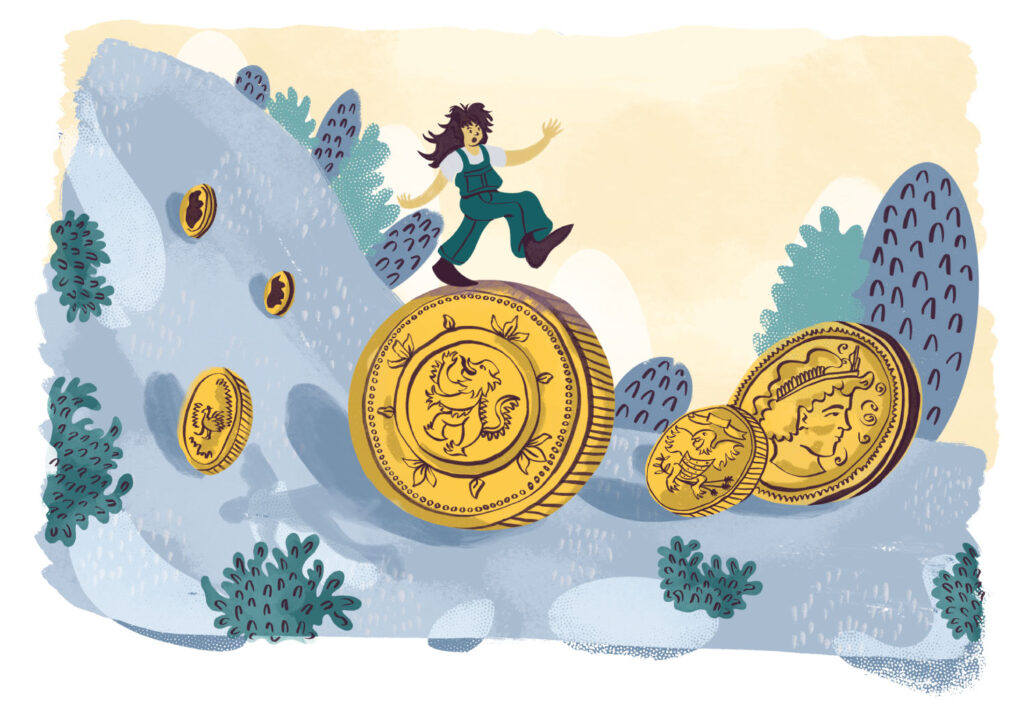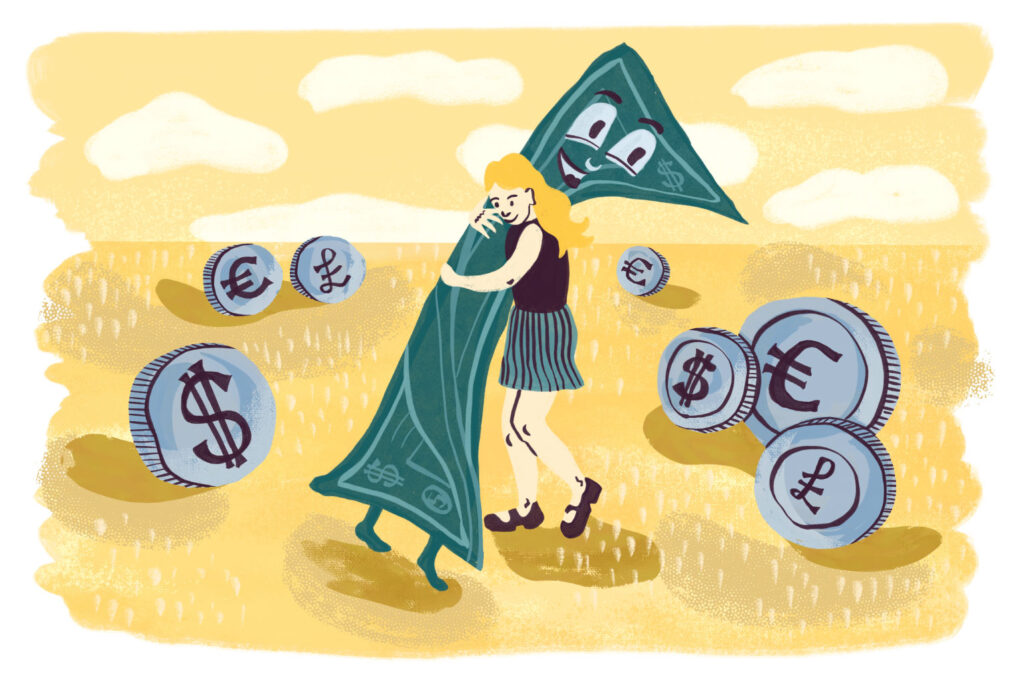
The History of Money Around the World

The History of Money
As long as man has walked the earth, he has wanted to work.
Money didn’t start out as something we traded in. Trading local goods and materials, and no, not like the newest Nintendo Switch, more along the lines of cotton, cement and marble is where it all began. This was called Bartering. According to the History of Money, Bartering means to give someone something in exchange for something else.
Much like you would trade football/soccer cards on the school playground. For example, you know that Ronaldo is more valuable than Rashford. But is he more valuable than Rashford and Messi combined? No.
This is how people saw cotton. Is cotton more valuable than marble? Maybe I could get more cotton to keep me warm if I gave my neighbour the marble I own for his house.
First, we must take a trip back through the History of Money to 9000 B.C (Before Christ) yes that right! 9000 years back before the Bible existed and people didn’t know who Jesus was. When the Earth was simply trees, water, and land…
Where it all began – the History of Money
Described as The Bronze Age, people were bartering quite a lot back then. However, it was proving difficult. Giving people things in exchange for something else only works if you have the item they need. There is no point in giving up a cow for a pair of high heels!
But the more people started to trade between their countries, the more they realised how valuable certain items were. Like silver, gold, coffee, pigs and cows. Or how little value some items had, such as hats, aluminium, and wood. Throughout the History of Money, different items and materials have lost and gained value.
The value or in value of these items was decided throughout the History of Money based on the following:
- How attractive
- Its use
- If it was a rare find
- How long it lasted
- How manageable the item was

All these values are still used today!
Around 3000 BC, people started storing these items of value in large temples for safekeeping. They were also using buildings like banks to trade grain, animals, and metal.
From Cowry to Coins – the History of Money
Cowry Shells were sought after all over China and Africa to pay for items.
By 1300 BC, they had designed bronze cowry shells to replace this. Anything else made of bronze, such as small-shaped knives and swords, was exchanged in China as the first form of currency. A big world of bronze shapes and designs being thrown around for other items.
This first attempt at making coins has led to the coins we have today made from Bronze, Silver, and Gold!
Local rulers, banks and leaders took these bronze coins and made them recognisable. People felt confident about using them to trade items. Almost as if you have ever won tokens from playing an arcade game. You can trade in your tokens for a prize.

All these values are still used today!
Around 3000 BC, people started storing these items of value in large temples for safekeeping. They were also using buildings like banks to trade grain, animals, and metal.
Coins to Banknotes – the History of Money
Carrying coins on you would be annoying. Imagine carrying £100 worth of coins to buy a food shop. It felt like this for many people back in the Bronze Age.
Around 600 A.D., China used the world’s first banknote. It was called Jiaozi.
By 1000 A.D., they were made a common form of payment across China. Typically, Chinese coins used to have a hole in the centre to string up these coins as a necklace. Soon realising that these necklaces were too heavy for people to carry, they altered and changed the course of history with banknotes!
It took 400 years to develop the banknote because people didn’t know whether to trust this payment. Banks weren’t sure that they could manage to keep this promise.
Marco Polo visited China in 1200AD and soon discovered that the Chinese were dealing with their finances using banknotes.
By 1661, Sweden had issued its first banknotes, which would quickly spread worldwide.
In 1816, the UK deemed that the gold standard would be given in exchange for the country’s currency. A £10 banknote would be equivalent to £10 worth of gold. Soon the world would catch on, and everyone would deal in banknotes in exchange for gold.
Today dollar banknotes say, ‘In God we Trust,’ but in 1000 AD, Chinese banknotes read, ‘Those who are counterfeiting will be beheaded.’ Talk about some gruesome history right there!

Money around the world today – the History of Money
Inflation soon began as many countries would need more gold to print banknotes in matters of emergency. Wars, starvation, and viruses would consume countries, and people would need banknotes to survive.
When they realised they didn’t have enough gold to give everyone, they stopped using it and created banknotes without gold. The amount of money that exists today is endless. This form of banknote is called Fiat Money.
Nevertheless, countries still do vary in wealth and fortune. Each country has wealth that can change every day. Many people work hard to take money from others and keep it in their country.
Currency is how to describe each country’s money. For example, the UK’s currency is Sterling Pounds. The USA is Dollars. Russia is Rubles. France is Euros. The value of a £1 coin is not the same as $1 or €1.
The wealthiest currency in the world is the Kuwaiti Dinar. Kuwait is in the Middle East, next to Iraq and Saudi Arabia. It is the wealthiest country because it owns a vast amount of oil.
Here is a list of the top 10 wealthiest currencies on the planet as of 1st January 2023:
- Kuwait – Kuwaiti Diner (د.ك)
- Bahran – Bahraini Diner (د.ب)
- Oman – Omani Rial (ر.ع)
- Jordan – Jordanian Diner (د.ا)
- Great Britain – Pound Sterling (£)
- Cayman Island – Cayman Islands Dollar ($)
- 27 Countries in the European Union – Euro (€)
- Switzerland – Swiss Franc (Fr.)
- Canada – Canadian Dollar ($)
- United States of America – US Dollar ($)
1 د.ك or 1 Kuwaiti Dinar = $3.26 or 3.26 United States Dollars
So, to put this into a real-life situation, buying a mirror worth $50 for your new bedroom in New York, USA, would only cost you 15.34 Kuwaiti Diner if you lived in Kuwait.
You may understand this if you have been on holiday with your parents to another country. Often your parents will go on holiday somewhere cheap to spend more money on ice cream, surfing and fancy hotels.
Here are some more examples of currency and its value to the US Dollar (Jan 2023):
$1 = £0.83
$1 = €0.94
$1 = 0.94 Swiss Fr.
Previously I said that currency could change every day. Adults know this, so they look at how much their money is worth. This is very important as you can give money to other people in other countries by going on holiday.
A way to see how much your money is worth in your country is to look at a currency’s exchange rate. You can look for yourself by going to the Google Currency Converter.
I said that $50 for a mirror in the USA is worth 15.34 in Kuwaiti Diner. But that also means that if you took a trip to the Middle East and found a mirror, it wouldn’t be priced at 18 Kuwaiti Diner.
Countries have different values for products and coins. You may be paid more in the Middle East for working as a shopkeeper than in the US. This may seem unfair, but different leaders created this system before we knew what was right and wrong. Today, these countries are some of the poorest or richest on the planet.
Electronic Money – the History of Money
In 1982, electronic money was created.
Banks have been keeping people’s money on record for a very long time. With the revolution of the computer – some of you may even have one of these, which has evolved into tablets, phones, and various screens – it allowed people to store a large amount of information in one place.
Money was to be carried by microchip onto plastic bank cards. With this, you could go into any store and buy items using a plastic card. The computer would then recognise this payment and deduct the money from your account in the bank. Clever right?
By 1995, Visa and Mastercard successfully bought these electronic plastic transactions into reality in the USA. Both companies are displayed on most bank cards these days. Try to ask a parent or a guardian if you can look at their card to see if it has the famous VISA or Mastercard logo.
By the year 2000, the world was following in America’s footsteps.
What we have learnt about the History of Money
From the expansive history of money its development has shown us that:
- Investing and saving is vital to holding onto and growing money worldwide, whether in coins, paper, or on your phone.
- It is important to know man has created money to barter and get items from others.
- It is also key to understanding that man has evolved from the Bronze age and developed a way of trading with the online world.
- Fiat Money is now money that doesn’t hold any real value. It is a made-up system based on borrowing, lending, and exchanging.
- Money is constantly changing, and we think getting what you want from it is essential.
- You can trade, invest, and improve the value of your money by learning from the past by taking this teaching into the future.
Check out The Children’s Finance School to learn more about Money!
Learn More…
- Chinese Bronze Age – BBC Two – The Story of China – China’s Bronze Age
- Money bought to you by the BBC for KS1 students – Money – BBC Bitesize
- Learn more about inflation and how it was affected by historical events such as the World War – Who Wants to be a German Millionaire? 🇩🇪 | Woeful Second World War | Horrible Histories – YouTube






Responses